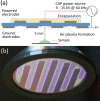Effective Fungal Spore Inactivation with an Environmentally Friendly Approach Based on Atmospheric Pressure Air Plasma
- PMID: 30657659
- PMCID: PMC6727216
- DOI: 10.1021/acs.est.8b05386
Effective Fungal Spore Inactivation with an Environmentally Friendly Approach Based on Atmospheric Pressure Air Plasma
Abstract
Fungal contamination of surfaces is a global burden, posing a major environmental and public health challenge. A wide variety of antifungal chemical agents are available; however, the side effects of the use of these disinfectants often result in the generation of toxic residues raising major environmental concerns. Herein, atmospheric pressure air plasma generated by a surface barrier discharge (SBD) is presented as an innovative green chemical method for fungal inactivation, with the potential to become an effective replacement for conventional chemical disinfection agents, such as Virkon. Using Aspergillus flavus spores as a target organism, a comparison of plasma based decontamination techniques is reported, highlighting their respective efficiencies and uncovering their underpining inactivation pathways. Tests were performed using both direct gaseous plasma treatment and an indirect treatment using a plasma activated aqueous broth solution (PAB). Concentrations of gaseous ozone and nitrogen oxides were determined with Fourier-transform infrared spectroscopy (FTIR) and Optical emission spectroscopy (OES), whereas hydrogen peroxides, nitrites, nitrates, and pH were measured in PAB. It is demonstrated that direct exposure to the gaseous plasma effluent exhibited superior decontamination efficiency and eliminated spores more effectively than Virkon, a finding attributed to the production of a wide variety of reactive oxygen and nitrogen species within the plasma.
Conflict of interest statement
The authors declare no competing financial interest.
Figures









Similar articles
-
Decontamination of Aspergillus flavus and Aspergillus parasiticus spores on hazelnuts via atmospheric pressure fluidized bed plasma reactor.Int J Food Microbiol. 2016 Jan 4;216:50-9. doi: 10.1016/j.ijfoodmicro.2015.09.006. Epub 2015 Sep 12. Int J Food Microbiol. 2016. PMID: 26398284
-
Inactivation of bacterial endospores on surfaces by plasma processed air.J Appl Microbiol. 2020 Apr;128(4):920-933. doi: 10.1111/jam.14528. Epub 2019 Dec 9. J Appl Microbiol. 2020. PMID: 31758752
-
High voltage atmospheric cold plasma treatment inactivates Aspergillus flavus spores and deoxynivalenol toxin.Food Microbiol. 2021 May;95:103669. doi: 10.1016/j.fm.2020.103669. Epub 2020 Nov 5. Food Microbiol. 2021. PMID: 33397632
-
Cold atmospheric pressure plasma and decontamination. Can it contribute to preventing hospital-acquired infections?J Hosp Infect. 2014 Oct;88(2):59-65. doi: 10.1016/j.jhin.2014.06.015. Epub 2014 Jul 29. J Hosp Infect. 2014. PMID: 25146226 Review.
-
The State of Research on Antimicrobial Activity of Cold Plasma.Pol J Microbiol. 2019;68(2):153-164. doi: 10.33073/pjm-2019-028. Pol J Microbiol. 2019. PMID: 31250588 Free PMC article. Review.
Cited by
-
Application of Pinhole Plasma Jet Activated Water against Escherichia coli, Colletotrichum gloeosporioides, and Decontamination of Pesticide Residues on Chili (Capsicum annuum L.).Foods. 2022 Sep 15;11(18):2859. doi: 10.3390/foods11182859. Foods. 2022. PMID: 36140988 Free PMC article.
-
Disinfection of Escherichia coli in ice by surface dielectric barrier discharge plasma.Appl Phys Lett. 2021 Aug 30;119(9):090601. doi: 10.1063/5.0064020. Appl Phys Lett. 2021. PMID: 34548671 Free PMC article.
-
Cold atmospheric plasma inactivates Aspergillus flavus and Fusarium keratoplasticum biofilms and conidia in vitro.J Med Microbiol. 2024 Jul;73(7):001858. doi: 10.1099/jmm.0.001858. J Med Microbiol. 2024. PMID: 38985505 Free PMC article.
-
Bioaerosol Inactivation by a Cold Plasma Ionizer Coupled with an Electrostatic Precipitator.Microorganisms. 2024 Sep 21;12(9):1923. doi: 10.3390/microorganisms12091923. Microorganisms. 2024. PMID: 39338597 Free PMC article.
-
Optimization of low-temperature nitrogen plasma in reducing fungi and aflatoxin human exposure through maize.Sci Rep. 2025 Apr 5;15(1):11707. doi: 10.1038/s41598-025-95153-0. Sci Rep. 2025. PMID: 40188250 Free PMC article.
References
-
- Nelson J. H. Production of blue cheese flavor via submerged fermentation by Penicillium roqueforti. J. Agric. Food Chem. 1970, 18 (4), 567–569. 10.1021/jf60170a024. - DOI
Publication types
MeSH terms
Substances
LinkOut - more resources
Full Text Sources

